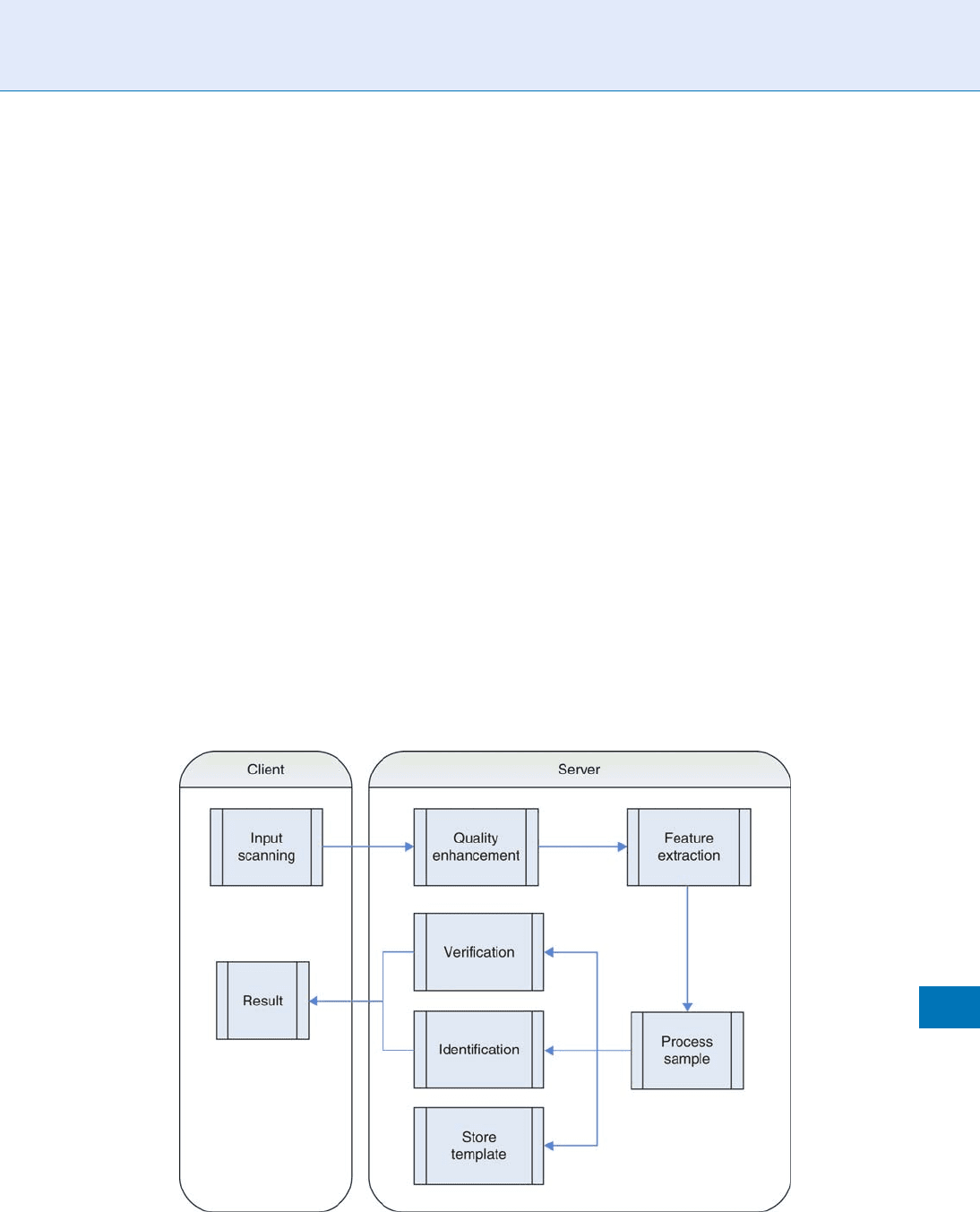Li S.Z., Jain A.K. (eds.) Encyclopedia of Biometrics
Подождите немного. Документ загружается.


verification in the selling of guns and for credit card
transactions that involved large sums of money.
In March 2005, TNS and TRUSTe commissioned
an Internet survey of attitudes to the application of
biometrics [12]. Nearly three years after the ORC
study, the awareness of biometrics in the US popula-
tion had risen to 75%. As in the 2001–2002 study,
substantial majorities suppo rted the government use
of these technologies, although a group of 15–20% of
subjects were opposed to some of the more conten-
tious applications such as use by employers for identity
verification and in national identity systems. A com-
parison of US with Canadian respondents in this re-
search showed that use in the private sector is viewed
with more suspicion in Canada (e.g., 55% in the US
would suppor t the use of biometrics in employer iden-
tity schemes in contrast to 36% of Canadians).
In a question about the acceptability of different
modalities for proving identity, fingerprint recognition
was a clear leade r (81%, with 58% for iris methods
appearing in second place).
US respondents were also asked about some of
the negative aspects of deploying biometrics at scale.
The technologies themselves were trusted, but they
were seen as expensive and likely to be defeated by
criminals; a significant propor tion would not trust
governments to limit the use of biometric data to
originally stated aims.
In 2004, UKPS, the UK Passport Ser vice, analyzed
attitudes to the use of biometrics as part of a very
large scale enrolment trial for those biometric tech-
nologies that had been proposed for the National
Identity Scheme: facial, fingerprint, and iris recogni-
tion [13]. With a total of more than 10,000 partici-
pants, this is one of the largest trials ever undertaken.
Two thousand individuals formed a quota sample,
representing the diversity of the UK population, with
an additional 750 subjects with a range of disabilities.
The remaining users included some who applied di-
rectly to participate in the trial. In addition to testing
the processes of biometric enrolment, a major goal was
to assess the customer experience of recording biomet-
ric features.
The overwhelming majority of participants in the
UKPS trial found that, overall, the experience was at
least as good as they had anticipated, althou gh the iris
recognition system experience was noted as least satis-
factory, comments being made about the need to re-
main still and wait for a long time. Advances in
technolog y since 2004 have aimed to address both of
these criticisms.
In general, the majority of the group of trialists was
not overly concerned about the recording of biometrics
(with the exception of comments by disabled people
about the use of iris systems). Concerns were lessened
after users enrolled into the system. It was notable,
however, that greatest concern regarding the use of
biometrics was exp ressed by the Black and Minority
Ethnic group and by subjects aged between 18 and 34.
In the quota group, iris recognition was the pre-
ferred biometric for males (iris as a first choice for
51%, with a second preference for fingerprints at
24%), female participants preferring this moda lity to
fingerprint use (45% against 36%).
In answer to the question of whether they were in
favor of biometrics being used as a means of identifi-
cation for passport purposes, over 90% of the quota
group were either ‘‘in favor’’ or ‘‘strongly in favor.’’ In
line with their concerns about iris biometrics, disabled
people were somewhat less in favor of its use in this
context.
In September 2008, the Lieberman Research Group
conducted a survey in a number of European countries
to ascertain concerns about national and personal
financial security, secu rity of dealing on the Inte rnet,
and people’s personal safety [8]. For the first time, this
annual survey included a supplementary question
about biometrics, enabling a comparison of attitude s
toward the use of these technologies across a number
of European countries. The question was posed
as: ‘‘Which of the following (... methods of authen-
tication...) would you be willing to use to verify your
identity with banks and government and other
organizations to prevent fraudulent misuse of your
personal information?’’ The interpretation of the
results has to be viewed against the generally threaten-
ing world, of which participants were reminded in
the earlier part of the survey, and the lack of any
further information regarding the technologies them-
selves – or the participants’ familiarity with them. The
question also brings together use by both public and
private sectors, whereas earlier studies have shown
significant differences in acceptance.
In all the seven European countries surveyed, the
order of acceptance of biometric technologies is finger-
print, eye scan, and voice. ‘‘A scan of blood vessels in
your hand’’ was least acceptable of the five modalities.
Some countries appear to be noticeably more willing to
1360
U
User Acceptance

use biometrics. For example, willingness to use finger-
print systems is highest in Netherlands (80%) and the
UK (75%), and lowest in France (58%). The surveys
picked up some significant differences in user accep-
tance for certain age groups and between males and
females in a number of countries. For example, in the
Netherlands, less than 50% of the 18–34 age group
were w illing to consider offering a face image for veri-
fication, whereas two-thirds of the over 65s would,
in principle, find this acceptable. However, caution
should be exercised in interpreting such trends, since
the survey respondents’ mental models of biometric
technologies could be at variance with reality.
Technologies
Smaller scale studies have attempted to understand
the issues of user acceptance in respect of individual
biometric technologies. In several of the major studies,
fingerprint technology has been rated as most ac-
ceptable. For example, in the Trustguide focus group
studies [6], it was seen as the ‘‘least invasive and the
most acceptable form of biome tric identification.’’
The report authors mention that this could be
context-specific, and may reflect the perception of
high accuracy in its use in the detection of crime.
In a study of the use of fingerprint biometrics,
researchers from the Canadian National Research Coun-
cil questioned a sample of 24 individuals in order to
understand some of the considerations that might be
influencing comments by users [14]. These subjects
were firstly asked to simulate a number of Internet
purchases, using biometrically secured personal or cor-
porate credit cards. In the discussion afterwards, there
was considerable confusion about the security value
of biometrics, but users felt that they were likely to
accept the technology once it became more prevalent.
Privacy concerns were mentioned without being rated
as overly important. However, as the facilitator probed
more deeply, subjects began to be less certain of their
acceptance. Even though this was a limited study, it
points to the need for more detailed investigation of
users’ perceptions and willingness to use these
modalities.
Occasionally, comments have been made in the lit-
erature about the fears of disease transmission, as users
touch the surface of conventional fingerprint sensors
one after another. In some deployments, cleaning tissues
are provided, while users are reminded of the numerous
occasions on which they touch common surfaces such
as door handles and terminals. For a small number of
deployments, these assurances may not be sufficient.
Munyan at Computer Sciences Corporation reports
that the immigration control authorities in one Asian
country required the decontamination of the fingerprint
sensor before every use by travelers [15].
In the evalu ations of user acceptance described
earlier, voice verification has not been rated highly in
spite of its growing application in corporate password
reset systems. Attitudes to its possible use were ex-
plored in a Harris Interactive telephone poll conducted
in April-May 2008 with 553 UK residents who had
been in contact with a Customer Service Center during
the previous year [16]. A description of the process of
enrollment resulted in only 38% of subjects rating it as
a technology they would be likely to use, even though
60% were confident that it was secure. By listening to
a demonstration, the willingness to accept voice bio-
metrics increased to 51%. (As in services using other
biometric modalities, users seem to need reassurance
about the impact of verification failure on their every-
day lives.) Additional data in this survey suggest that
those who did not accept speaker recognition were
also concerned about unrelated aspects of automation
of the phone interaction with the service provider.
Strategies for managing the handover between a
failed speaker verification session and a human opera-
tor have been examined in an earlier UK study [17].
Two-hundred and seventy onesubjects were authenti-
cated over the public telephone network. From the
options investigated, subjects preferred the protocol
of a messag e: ‘‘I’m sorry the voice verification process
has not been successful, please hold while I connect
you to a human operator’’ after two failed machine
verifications. Research with a small number of subjects
in the US hints at the need for operators to communi-
cate trust during any speaker verification dialog [18].
To assess the likely acceptance of a biometric tech-
nology in the context of an application, focus groups
can be used at first to elicit major concerns. This
qualitative research should inform the desig n of ques-
tionnaires that can then track changes in acceptance, as
individuals experience the application in both in-
house and public-facing trials.
A successful six-month trial of iris recognition in a
banking (public ATM) context demonstrates this ap-
proach [9]. At the beginning, focus groups identified
User Acceptance
U
1361
U

issues of trust, questioning whether such a ‘‘futuristic’’
technolog y could be used in consumer financial trans-
actions, as well as noting health concerns. Participants
in the groups were also invited to review proposals for
a marketing campaign. In the second (questionnaire)
stage, concerns with reliability, health aspects, and data
misuse surfaced – even before participants were ex-
posed to the technology. As users became familiar
with the use of iris biometrics, progressively higher
levels of acceptance were recorded as users enrolled in
the system, used an early prototype to withdraw cash,
and then experienced the final prototype.
Subsequently, the 1998 public trial in Swindon,
UK (with about 400 users from the general public)
confirmed this progression: from 44% comfort levels
directly after iris enrolment to 94% after use of the
IRIS ATM.
Applications
Biometric technologies are integrated into applications
that deliver a service to an operator or individual, and
users may not separate the biometric aspects from con-
cerns about the application [19]. In such cases, the
results of user acceptance testing will be partly deter-
mined by the biometric technology and partly by the
application. For example, in a 2008 pilot for the UK’s
Identity Card for Third Country Nationals [20], a high
degree of user satisfaction was recorded for the process
as a whole. Over 12,000 sets of facial images and ten
fingerprints were recorded, stored, and matched. The
analysis of feedback forms showed that in excess of
90% of the customers rated the enrollment service as
satisfactory. Dissatisfaction was registered by 8% of the
group – a figure that challenges the service designers to
improve the complete customer experience.
Summary
For many applications with a biometric element, user
acceptance is likely to be a key issue for their successful
operation. However, there has been an absence of sys-
tematic modeling of the nature of user acceptance in
such systems. Focus groups and oth er qualitative re-
search have identified some of the key determinants;
trust in the technology, fears of misuse of biometric
data, and health concerns have been mentioned.
It is unfortunate that the few larger-scale telephone
surveys on user acceptance have not followed up these
observations with more targeted questions. In any case,
few of the participants in these surveys would have had
any first hand experience of using a biometric system –
a key factor in improving user comfort and acceptance
of these novel technologies as evidenced in the UKPS
Biometric Enrollment and IRIS ATM trials.
Further research should be associated with the de-
sign, development, and piloting of new biometrically
enabled applications, with the aim of identifying the
main factors influencing user acceptance of technology
and application, both at enrollment and in service use.
Since the usability of a biometric system is believed to
play a substantial role in user acceptance, research
targeting both the aspects is recommended. However,
in the longer term, the goal should not be mere accep-
tance, but a positive degree of satisfaction with the
end-to-end service.
Related Entries
▶ Privacy
▶ Testing
▶ Usability
References
1. Dillon, A.: User acceptance of information technology: theories
and models. In: Williams, M. (ed.) Annual Review
of Information Science and Technology, vol. 31, pp. 3–32 (1996)
2. Venkatesh, V., et al.: User acceptance of information technology:
toward a unified view. MIS Quart. 27, 425–478 (2003)
3. Davis, F.: Perceived usefulness, perceived ease of use, and user
acceptance of information technology. MIS Quart. 13, 319–339
(1989)
4. Survey: so what do people think of biometrics? Biometrics
Technology. Today 3, 7–10 (1995)
5. Holmes, J.P., et al.: A performance evaluation of biometric
identification devices. http://infoserve.sandia.gov/cgi-bin/tech
lib/access-control.pl/1991/910276.pdf (1991)
6. Lacohee, H., et al.: Trustguide: final report. www.trustguide.org.
uk (2006). Last Accessed 24 March, 2009
7. ORC International: attitudes toward the uses of biometric identi-
fication technologies by government and the private sector. http://
www.search.org/files/pdf/Biometricsurveyfindings.pdf (2002).
Last Accessed 24 March, 2009
8. Unisys Security Index – November 2008 (Wave III). http://www.
unisyssecurityindex.com/resources/viewpoints/Executive%20sum
maryfinal.doc (2008). Last Accessed 24 March, 2009
9. Coventry, L., et al.: Usability and biometric verification at the
ATM interface. CHI Lett. 5(1), 153–160 http://research.iiit.ac.in/
1362
U
User Acceptance

vandana/PAPERS/BASIC/large-scale-ATM.pdf (2003). Last
Accessed 24 March, 2009
10. Biovision consortium: Biovision: roadmap for biometrics In
Europe to 2010. http://ftp.cwi.nl/CWIreports/PNA/PNA-
E0303.pdf (2003). Last Accessed 24 March, 2009
11. TNS/TRUSTe: Consumer attitudes about biometrics in ID docu-
ments. http://www.truste.org/pdf/Biometrics_Study.pdf (2005).
Last Accessed 24 March, 2009
12. Atos Origin: UK Passport Service Biometrics Enrolment Trial.
http://www.ips.gov.uk/passport/downloads/UKPSBiometrics_
Enrolment_Trial_Report-Management_Summary.pdf (2005).
Last Accessed 24 March, 2009
13. Sasse, M.A.: Usability and user acceptance of biometrics. http://
www.cesg.gov.uk/policy_technologies/biometrics/media/usabil
ity_and_user_acceptance.pdf
14. Heckle, R.R., et al.: Perception and acceptance of finger-
print biometric technology. In: Proceedings of the Symposium
on Usable Privacy and Security (SOUPS) National Research
Council Canada. http://iit-iti.nrc-cnrc.gc.ca/iit-publications-iti/
docs/NRC-49363.pdf (2007). Last Accessed 24 March, 2009
15. Munyan, D.: Coming clean on hygiene. Biometrics Technology.
Today 13(4), 7–8 (2005)
16. Nuance: Understanding consumer perspectives on voice
biometrics. Corporate publication (2008)
17. Dialogues Spotlight Research Team: dialogues for speaker
verification/operator handover. http://spotlight.ccir.ed.ac.uk/
public_documents/technology_reports/No.5%20Verification.
pdf (2000). Last Accessed 24 March, 2009
18. Turner, C.W., et al.: The effects of use on acceptance and
trust in voice authentication technology. In: Proceedings of
the Human Factors and Ergonomics Society 50th Annual
Meeting, Human Factors & Ergonomics Society, Santa,
Monica, CA, pp. 718–722 http://triangleinnovation.com/Docu
ments/HFES2006VoiceAuthTrust.pdf (2006)
19. Patrick A.: Acceptance of biometrics: things that matter that
we are ignoring. In: International Workshop on Usability and
Biometrics, NIST: Washington, D.C. http://zing.ncsl.nist.gov/
biousa/docs/workshop08/day1/7Patrick/Andrew-Patrick-Accep-
tance-of-Biometrics.pdf (2008). Last Accessed 24 March, 2009
20. UK Border Agency: Biometric enrolment pilot evaluation –
executive summary. http://www.ukba.homeoffice.gov.uk/site
cont ent/docum ents/managingourborders/biometricenrolment
evaluation (2008). Last Accessed 24 March, 2009
User Interfaces
User interfaces are systems (including hardware and
software components) that facilitate the interaction of
users with the system.
▶ Biometric Systems, Agent-Based
User Interface, System Design
JIANJIE LI,XIN YANG,XUNQIANG TAO,JIE TIAN
Institute of Automation, Chinese Academy of Sciences,
Beijing, People’s Republic of China
Synonyms
Interface; Graphical user interface
Definition
The User Interfaces have been around as long as com-
puters have existed, even well before the field of
Human–Computer Interaction was established [1, 2].
The user interface provides means of: input, allow-
ing the users to manipulate a system; output, allowing
the system to produce the effects of the users’ mani-
pulation [3].
Introduction
Computer software has become pervasive in today’s
society. How to design and create easy usable softwar e
is the central issue in software development. As new
software products are developed the emphasis has often
been on what features and function they contain rather
than how the features are used. This emphasis is often
reflected as user interface. The user interfaces are the
main and dispensable components of any softwar e [2].
The user interface is often used in the context of
computer systems and electronic devices. The user
interface of a mechanical system, a vehicle, or an
industrial installation is sometimes referred to as the
Human–Machine Interface (HMI) [4]. HMI is a
modification of the original term Man–Machine Inter-
face (MMI). In practice, the abbreviation MMI is
still frequently used, although some may claim that
MMI stands for something different now. Another
abbreviation is Human–computer interaction (HCI)
[5], but is more commonly used for Human–computer
interaction than Human–computer interface. In a
word, the terms refer to the ‘‘layer’’ that separates
a human who is operating a machine from the machine
itself [3].
User Interface, System Design
U
1363
U

When designing human/computer systems, the
user interface between human and system is crucial.
It is the communication channel that end-user can
interact with a system [5]. A good user interface is to
find out user tasks as one of the first steps and driven in
large part by human aesthetics in their look and feel
[6]. Users have to be able to control the system and
access the state of the system . For example, when
driving an automobile, the driver uses the steering
wheel to control the direction of the vehicle, and the
accelerator pedal, brake pedal, and gear stick to control
the speed of the vehicle. The driver perceives the posi-
tion of the vehicle by looking through the windscreen
and exact speed of the vehicle by reading the speedom-
eter. The user interface of the automobile is the instru-
ments that the driver can use to accomplish the tasks of
driving and maintaining the automobile [2]. In a bio-
metric’ system design, the user interface refers the
aggregate designed into an information device with
which a human being may interact. The user interface
should provide means of ‘‘Input’’ which allows the
users to manipulate a system and ‘‘Output’’ which
allows the system to produce the effects of the users’
manipulation.
User interface design is an expensive, complex, and
time consuming process [7]. To provide an environ-
ment where developers can design and implement user
interfaces in a professional and systematic w ay, there
are a lot of good software to help developers design and
implement the user interface such as QT and MFC.
In biometric system design, the user interface is a
little different from other system design. Biometric
system always has capture device for input biometric
feature. The graphical user interface should have a
picture control to show the image of the capture, and
the user can discard the image because of poor quality.
The biometric system need to set the parameter for
different purpose. So user interface need to have some
interaction with the user. There is two kind of system,
one for Single mode and the other for Client/Server
mode.
Single Mode
The single mode means all the system run on a single
PC. That is a common mode. It is simple in system
design, easy to install, and undertaken on a small scale.
Figure 1 shows the architecture of the single mode.
When system works in single mode, UI can be de-
scribed as follows:
1. User interface include a page or dialog including
some exit boxes or scroll bars that can set the
configuration of the system. This step initializes
the biometric system.
User Interface, System Design. Figure 1 Architecture of the Single mode.
1364
U
User Interface, System Design

2. User inte rface include the button like ‘‘connect the
capture’’ to make ready of the capture, then call the
capture’s API to try to open the sensor or camera.
If the capture is ready, the program opens the
corresponding capture interface. Then a biometric
feature can be captured. If any error happens, the
program return a message box or show a message
on the dialog, which let the user know that the
capture is not ready. The user interface also shows
where the error occurred, which help the user to
find the problem.
3. When the biometric feature is captured, the user
interface shows the image to the user. Note that a
good automated image mechanism ought to be
employed so that the system will be able to obtain
an image of sufficient quality. If the image does not
have enough quality, the user interface should can-
cel current image, and let the user capture the
biometric feature again.
4. There is a push-button interface to select from two
applications: Enrollment and Match. In enrollment
process, user should input other information like
ID number, age, sex, etc. That may need several edit
boxes, scroll bars, and combo boxes. After that, a
message should be given to tell the user whether
Enrollment or Match succeeds or not.
5. In single mode, the biometric feature does not
always have a database. Instead, program store the
feature in a folder with some files. And some use
the desktop database like Microsoft Access. What
ever, the user interface could check the database
conveniently if possible.
Client/Server Mode
In client/server mode, there is a high performance com-
puter called server, the algorithms are run in server, and
the entire database are stored in server. Figure 2 shows
the architecture of the client/server mode. There are
server advantages in client/server mode [8].
1. The client PC may not have sufficient power to run
the algorithms on real-time.
2. The user database maybe on a server and that is a
safe mode.
3. The matching algorithms will execute in a more
secure environment.
User Interface, System Design. Figure 2 Architecture of the Client/Server mode.
User Interface, System Design
U
1365
U

4. Identification over large populations can only rea-
sonably be done on a server.
The client part is a common PC. It is used for input
or scans the biometric feature, show the result from
the server.
1. The user interface include s the button to make
ready of the capture, then call the capture’s API to
try to open the sensor or camera. If the capture is
ready, the program opens the corresponding cap-
ture interface. If some error occurred, the program
should return a message box or show a message on
the dialog, which let the users know the capture is
not ready. The user interface should show where
the error occurred, which make the user easy to
find the problem.
2. When the biometric feature is captured, the user
interface shows the image on the dialog to the user.
That can let user make sure the image is suitable for
the situation. In some situation, user should also
input some information like ID number,
age, sexual, etc. If the image does not have enough
quality, the user interface should cancel current
image, and let the user capture the biometric feature
again.
3. The user interface should have a button to connect
the server. If the server is ready, then the client could
transfer the biometric feature and other information
to the server using net protocol, and also tell the
server what to do with these in formations. For
example, verify with the ID number, or identify in
a database. If there are some errors occur in this
process, the program should show a message on
the dialog in order to let the user know what and
where the error is.
4. After the server calculates for a moment, the client
will receive a message about the result from the server.
The user interface should change the numeric result
to an intuitionist message, and show it on the dialog,
for example, a message box or an obvious picture.
And user could decide whether to capture it again.
The server is a high performance computer. It can store
the database; calculate the huge operation in very short
time. It has a super user who has the greatest power.
1. The user interface has a log in dialog for user to
input the name and password. It also can capture
the biometric feature to log in.
2. User inte rface need to manage the common users.
That interface should include a list of all the users.
When click one of them, the interface should show
all the detail about this user. There is a button to
show a dialog, and allow super user change the
common user’s competence or details. In this dia-
log, super user can insert or delete a common user.
3. User interface need to manage the parameter of the
system and the algorithms. This interface should
correspond to the project. It can change the match
score parameter to decide if it necessary to reduce
the false accept rate (FAR).
4. User interface needs to manage the database. The
program connects to the database and has a dialog
to show the detail. The super user can delete or
insert a record by push the corresponding button.
Summary
Technology alone may not win user acceptance
and subsequent marketability. The user experience, or
how the user experiences the end product, is the key to
acceptance [9]. The importance of good user interface
design can be the difference between product accep-
tance and rejection. So, in biometric’ system design
good User Interface Design must make a product
easy to understand and use, which can result in greater
user acceptance.
Related Entries
▶ Biometric System Design, Overview
References
1. Jorgensen, A.H., Myers, B.A.: User interface history. In: Proceed-
ings of Conference on Human Factors in Computing Systems,
Florence, Italy, pp. 2415–2418 (2008)
2. Jean, A., Pratt, Hauser, K., Ugray, Z., Patterson, O.: Looking
at Human–Computer Interface Design: Effects of Ethni-
city in Computer Agents. Interact. Comput. 19(4), 512–523
(2007)
3. http://en.wikipedia.org/wiki/User_interface
4. Krepki, R., Curio, G., Blankertz, B., Berlin, K.R.M.: Brain-
Computer Interface-The HCI Communication Channel for Dis-
covery. Int. J. Hum. Comput. Stud. 65(5), 460–477 (2007)
1366
U
User Interface, System Design

5. Apple. Apple human interface design guidelines: Introduction to
apple human interface guidelines (2006)
6. Kamal, A., Asad, I., Bashar, B.A., Alaa.: Teaching human com-
puter interaction methods in embedded system design 2008. In:
Proceedings of Third International Conference on Information
and Communication Technologies: From Theory to Applica-
tions, pp. 1–6. Damascus, Syria (2008)
7. Russo, G., Birtolo, C., Troiano, L.: Generative UI design in SAPI
project. In: Proceedings of Conference on Human Factors in
Computing Systems, Florence, Italy, pp. 3627–3632 (2008)
8. http://www.usernomics.com/user-interface-design.html
9. BioAPI 2.0, BioAPI Consortium: (2005). http://www.bioapi.org/
Version_2.0_Description.asp. Accessed 2005
User-Centered Design
Pheasant summarized ergonomic design by the princi-
ple of user-centered design, which ‘‘If an object, a
system, or environment is intended for human use,
then its design should be based upon the physical and
mental characteristics of its human users’’. Moreover
Woodson states the design should allow users to com-
plete the desired functions and tasks with minimal
stress and maximum efficiency. Therefore, the object
of ergonomics and user-centered design is to achieve
the best possible match between the product and users
in the context of the task to be performed. Chignell and
Hancock referred to this as the ‘‘design triad,’’ which
consists of three primary relationships. The first is the
user-task relationship, which is much like task analysis
and answers the following questions: What is the task,
and how is it carried out by the user? The second
relationship is user-artifact, which is the relationship
between the user and the system and lies at the heart of
ergonomics. Lastly, the artifact-task relationship repre-
sents the methodology for using the system to perform
the task, which is also known as methods improve-
ment. Other techniques, methods, and practices of
U ser-centered Design besides usability testing and audits
include: interviews, focus group research, surveys, de-
sign, cognitive, or structured walk-throughs, paper and
pencil evaluations, expert evaluations, field studies, and
follow-up studies.
▶ Ergonomic Design for Biometric Systems
User-dependent Fusion
▶ Fusion, User-Specific
Utility
Utility is the observed performance of a sample in a
biometric system, or similarly the impact of an individ-
ual biometric sample on the overall performance of a
biometric system. The characteristic of the sample
source and the fidelity of the processed samples contrib-
ute to or similarly detract from the utility of the sample.
▶ Speech Production
Utterance
Utterance is a spoken input speech sample. It may be
real time streaming audio, a prerecorded file, or the
result of buffering. In interactive systems, a single utter-
ance generally corresponds to a single interaction turn.
▶ Speaker Recognition, Standardization
Utterance
U
1367
U


V
Vascular Biometrics
▶ Vascular Image Data Format, Standardization
Vascular Image Data Format,
Standardization
ALEX H. CHOI
1
,JONATHAN R. AGRE
2
1
Department of Information Engineering Myongji
University, Seoul, South Korea
2
Fujitsu Laboratories of America College Park,
MD, USA
Synonyms
Vascular biometrics; Vein biometrics
Definition
AVascular ▶ Biometrics, Overview Image Format Stan-
dard is useful for the exchange of vascular biometric
image information across different systems developed
by multiple organizations. As one part of this standar-
dization effort, the International Standard Organization
(ISO) has published a standard for a vascular biometric
image interchange format, which is the ISO/IEC 19794-
9 (Biometric Data Interchange Format – Part 9 Vascular
Image Format). The standard includes general require-
ments for image capture devices, environmental condi-
tions, specific definitions of image attributes, and the
data record format for storing and transmitting vascu-
lar biometric image s. The vascular biometric image
format standard was developed in response to the
need for system interoperability which allows different
vascular biometric systems to be easily integrated with
other biometric modalities in a large-scale system.
Introduction
Vascular biometric technologies have existed for many
years. Moreover, new technologies employing vascular
images obtained from various parts of the human body
are emerging or under continuous improvement as a
result of new, state-of-the-art imaging devices. Some of
these technologies are being widely adopted as reliable
biometric modalities [1].
Vascular biometrics offer several intrinsic advan-
tages in comparison with the other popular biometric
modalities. First, the vascular imaging devices use
near-infrared or infrared images to capture the vein
pattern underneath the skin. This provides a high
degree of privacy that is not available with fingerprints,
which can be unintentionally left on objects, or by
facial images for face recognition schemes, which are
easily captured without ones knowledge. A similar
possibility exists for iris images captured without con-
sent for use in iris recognition schemes. Second, the
vascular imaging devices can be constructed to operate
in a non-contact fashion so that, it is not necessary for
the individual to touch the sensor in order to provide
the biometric data. This is advantageous in applica-
tions that require a high degree of hygiene such as
medical operating room access or where persons are
sensitive about touching a biometric sensing device.
Third, a high percentage of the population is able to
provide viable vascular images for use in biometric
identification, increasing
▶ usability by providing an
additional way to identify persons not able to provide
fingerprints or other biometric modal data. Fourth,
depending on the particular wavelength of (near-)
infrared light that is used, the image can capture only
the vein patterns containing oxygen depleted blood.
This can be a good indication that the biometric image
is from a live person. Fifth, the complexity of the
vascular image can be controlled so that the underlying
amount of information contained in the image can be
quite high when compared to a fingerprint, allowing
one to reduce the false accept or false reject rates to low
#
2009 Springer Science+Business Media, LLC
